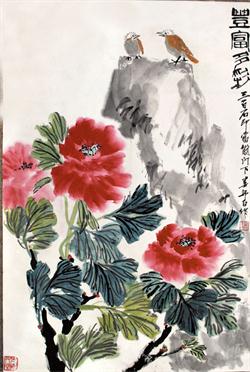国画在用墨上的技巧:国画历史悠久并不断创新,从古今,很多名人画家给字画艺术文化的发展带来了的发展。国画也同时不断走向成熟,并成为艺术投资中的为之关注的一个投资项目。今天就来详细讲述一下国画在用墨上的技巧。
Chinese painting in ink skills: Chinese painting has a long history and continuous innovation, since ancient times, many famous painters have brought the development of calligraphy and painting art and culture. At the same time, traditional Chinese painting is becoming more and more mature and has become an investment project in art investment. Today, let's talk about the skills of using ink in traditional Chinese painting.
(1)墨彩
(1) Ink color
墨本来是一种单色,但由于国画把墨当作色彩来运用,所以有墨彩之说,意思即是墨色美在单纯中蕴含了万物的光彩。黑与白是亮度的对比,黑白对比适当,画面就生出亮彩。浓与淡是墨色阶梯的对比,于与湿是水分多少的对比。对比适当,墨即有色彩的光辉。
Ink is originally a kind of monochrome, but because traditional Chinese painting uses ink as color, there is the saying of ink color, which means that the beauty of ink color contains the brilliance of all things in simplicity. Black and white is the contrast of brightness, black and white contrast is appropriate, the picture will produce bright color. Thick and light is the contrast of the ink ladder, and the wet is the contrast of moisture. If the contrast is appropriate, the ink will have the brilliance of color.

(2)墨阶
(2) Mohist stage
墨色由浓到淡的层次变化叫墨阶。与色阶、音阶相似。墨阶大体可分为:焦、浓、重、淡、清五个阶梯。浓的、不掺水的墨为焦墨;掺少量水分,浓度仅次于焦墨者,为浓墨;掺三分之一的水,为重墨;水分超过墨者,为淡墨;水中掺少量墨者,为清墨。在实际作画时,可以把墨分成更细的层次。墨阶的作用,关系到画面色彩层次和调子,层次少,对比强,称之为高调;层次多,画面柔和丰富称为低调。调子的运用,要按画面的具体需要加以调整。
The level change of ink color from thick to light is called ink level. It is similar to color scale and tone scale. The ink steps can be roughly divided into five steps: Jiao, Nong, Zhong, Dan and Qing. The thick ink without water is coke ink; the ink with a small amount of water is thick ink; the ink with a third of water is heavy ink; the ink with more water is light ink; the ink with a small amount of water is clear ink. In actual painting, the ink can be divided into finer layers. The role of ink scale is related to the color level and tone of the picture. Less level and strong contrast are called high-key; more level and soft and rich picture are called low-key. The use of tunes should be adjusted according to the specific needs of the picture.
(3)墨质
(3) Ink quality
对墨的处理办法不同,产生不同质的变化叫墨质。可分:新、焦、宿、退、埃五种。新磨的浓墨,立即使用叫新墨。磨好的浓墨,放在砚台中半天以后,水分有一定的挥发,叫做焦墨。把墨放置以上,使水分有较多的挥发,叫做宿墨。宿墨由于部分脱胶,故运笔畅快、墨色浑厚,但光泽较差。放置多天的墨,墨中的胶力大部分脱去,炭粉沉淀严重,颗粒粗糙,光泽更差,但墨色厚重,笔痕清楚。埃墨是墨汁在砚台中长期放干之后,再用水泡起,墨质粗糙,一般不好使用,但在一些特殊效果中也可使用。
The treatment of ink is different, resulting in different changes called ink quality. Can be divided into: new, coke, home, back, Egypt five. New grinding of thick ink, immediately use called new ink. The ground thick ink, put in the inkstone for half a day, the water has a certain volatility, called coke ink. The ink placed for more than a day, so that the water has more volatile, called sumo. Due to partial degumming, the ink is smooth and thick, but the luster is poor. After being placed for many days, most of the adhesive force in the ink is removed, the carbon powder precipitates seriously, the particles are rough, and the luster is worse, but the ink color is thick and the pen mark is clear. Ebony ink is the ink in the inkstone after long-term dry, and then blister up, ink quality is rough, generally not easy to use, but in some special effects can also be used.
(4)墨性
(4) Ink quality
对于墨色的不同处理,产生色性的变化,叫做墨性。分枯、干、润、湿、漓五种。不同的墨性可以表现不同的形象和表情。如干燥和湿润,粗糙与光洁,苍老与稚嫩等。枯墨一般用宿墨,枯墨适宜表现老年人干枯的皮肤及粗糙的衣物等。干墨可以分浓干和淡干,无论浓淡,把笔中水分尽量吸干,用笔时会出现飞白,适宜表现人物的须发、山石、树干等。润墨干湿相宜,这种不干不湿之墨,用笔时略有水晕之感,使用范围广泛。湿墨指笔中饱含水分,行笔时,水分在纸上自然渗化,墨痕之处,有明显的墨晕,适合表现比较光洁的物体。漓墨为水气淋漓之墨,适合大面积渲染,表现烟雾、水气等。墨的干湿、枯润如果运用不当,就会破坏画面效果,太枯则无气韵;太湿则无骨气;太干则枯燥无味;太润则柔弱而无纹理。
For different treatment of ink color, color changes, called ink. It can be divided into five types: dry, moist, wet and dry. Different ink can express different images and expressions. Such as dry and wet, rough and smooth, old and young and so on. The dry ink is usually used for staying in the dark. The dry ink is suitable to show the dry skin and coarse clothes of the elderly. Dry ink can be divided into thick dry and light dry. No matter how thick or light it is, try to absorb the water in the pen as much as possible. When using the pen, it will appear white, which is suitable for the performance of the characters' hair, rocks, tree trunks and so on. Moistening ink is suitable for drying and wetting. The ink that is not dry and not wet has a slight water halo when using the pen, so it is widely used. Wet ink means that the pen is full of water. When writing, the water will naturally seep on the paper. There is obvious ink halo at the ink mark, which is suitable for the performance of relatively smooth objects. Li ink is a kind of water vapor ink, which is suitable for large-area rendering, showing smoke, water vapor and so on. If the ink is not used properly, it will destroy the effect of the picture. If it is too dry, it will have no aura; if it is too wet, it will have no backbone; if it is too dry, it will be dull; if it is too moist, it will be soft and without texture.
(5)墨法
(5) Ink method
用墨之法,前人有很多经验,总结起来主要有七法:浓墨法、淡墨法、焦墨法、宿墨法、破墨法、积墨法、泼墨法。黄宾虹先生说:“画案之上,一钵水,一砚墨,两者互用,是为墨法。”又说:“古人墨法,妙于用水。”所以墨法离不开水的运用。用墨七法,实际上是墨与水不同的调和与使用而变化出来的。
There are seven ways to use ink: thick ink, light ink, burnt ink, permanent ink, broken ink, accumulated ink and splashed ink. Mr. Huang Binhong said: "on the painting, there is a pot of water and an inkstone. The two are mutually used, which is the method of ink." Also said: "the ancients ink method, better than water." Therefore, ink cannot be separated from the use of water. In fact, the seven methods of using ink come from the different blending and use of ink and water.
